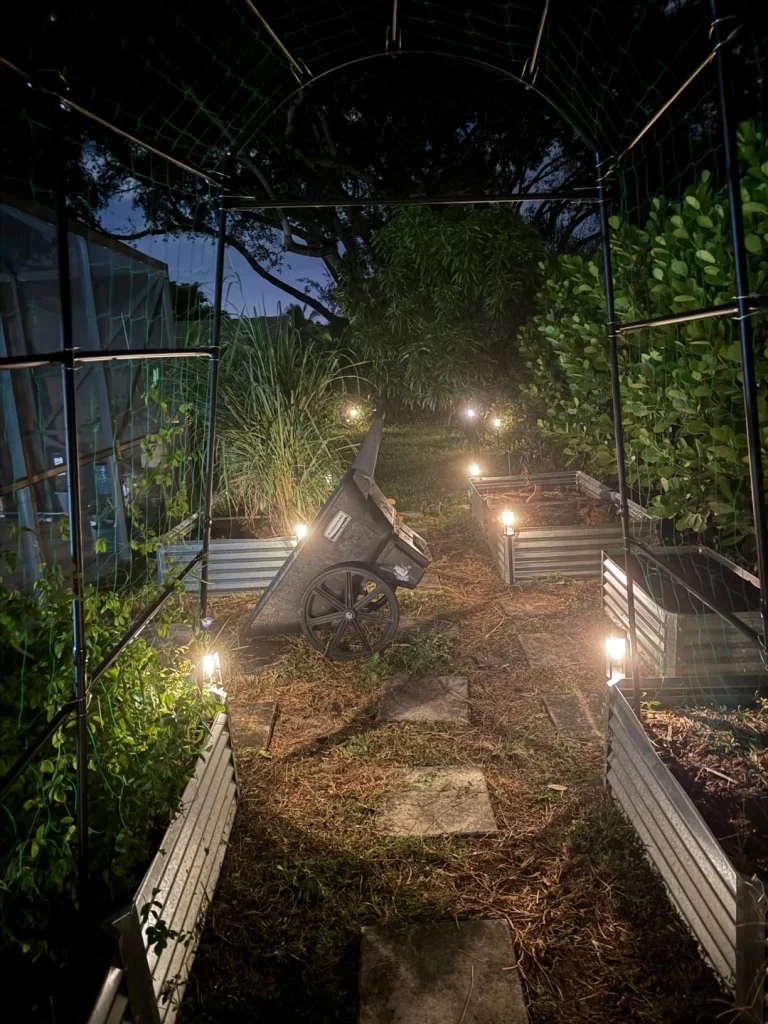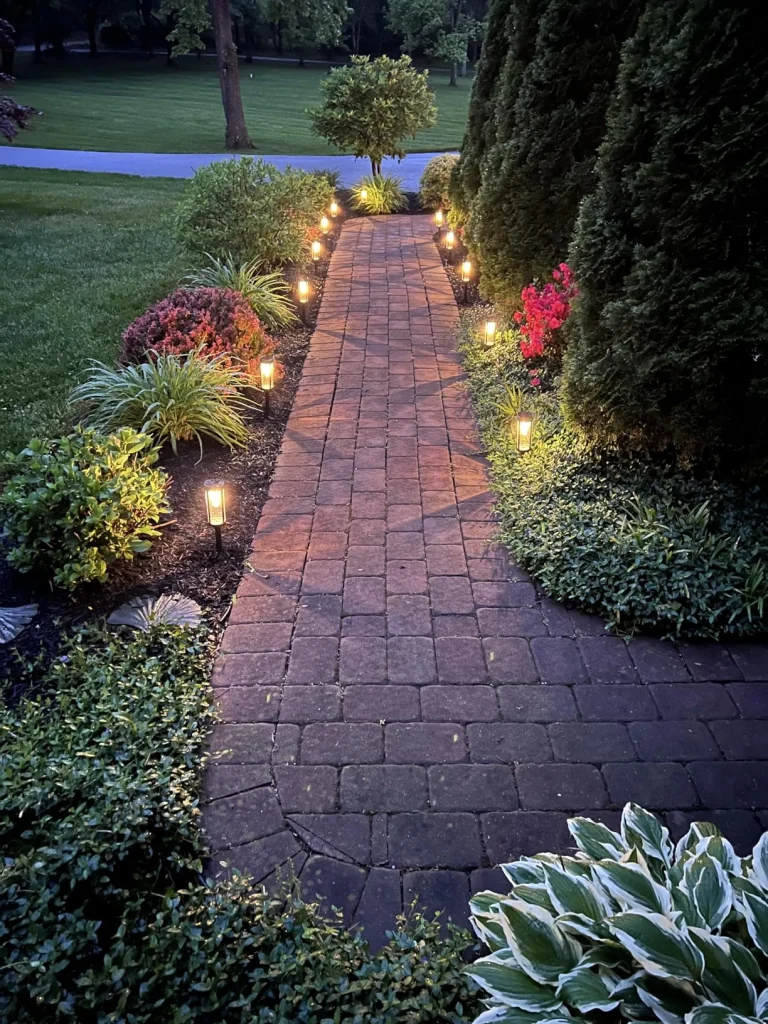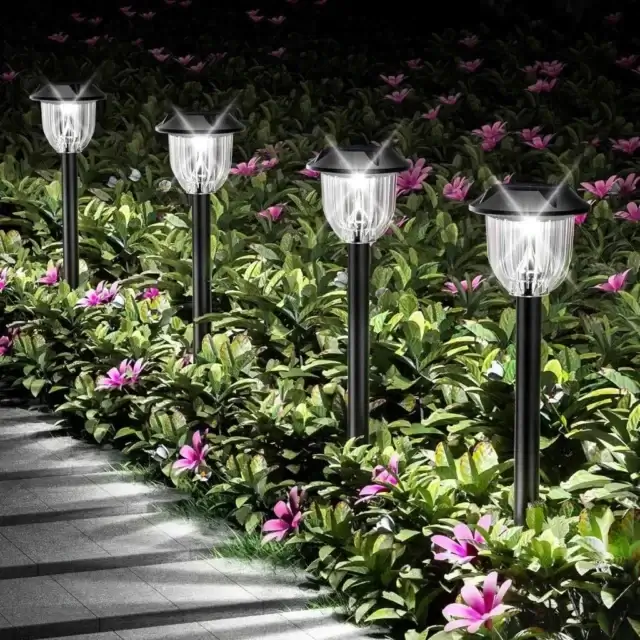Transforming outdoor spaces with LED solar landscaping lights offers a blend of aesthetics, sustainability, and practicality. These lights enhance gardens, pathways, and patios while aligning with eco-conscious principles. This guide explores how to design and implement a lighting system that harmonizes with nature, creates visual depth, simplifies installation, adapts to environmental changes, and optimizes long-term performance.

Ecological Synergy: Harmonizing Light with Nature
Creating a garden lighting design that supports local ecosystems is essential for sustainable outdoor spaces. LED solar landscaping lights can be tailored to minimize disruption to nocturnal insects and plants. The wavelength of light emitted by LEDs plays a critical role. Warm white LEDs, typically in the 2700K to 3000K range, emit softer tones that are less likely to attract insects compared to cooler, blue-heavy lights. Studies suggest that blue light wavelengths (around 450-470 nm) can interfere with pollinators like moths and fireflies, disrupting their navigation and mating patterns. By selecting warm-toned LEDs, homeowners can reduce these impacts, fostering a balanced backyard ecosystem.
Plants also benefit from thoughtful lighting. Many species rely on darkness for processes like dormancy or flowering. Over-illumination can stress plants, particularly those sensitive to photoperiodism, such as chrysanthemums or poinsettias. Positioning LED solar landscaping lights to avoid direct beams on plant beds ensures that foliage remains undisturbed during nighttime hours. For example, in a suburban backyard in Portland, Oregon, a homeowner used low-lumen solar lights along pathways, directing light downward to preserve the natural cycles of native ferns and shrubs. This approach not only protects flora but also enhances the garden’s nighttime appeal with subtle, focused illumination.
Incorporating motion sensors further reduces ecological impact. Lights that activate only when needed minimize light pollution, allowing fireflies to thrive and nocturnal pollinators to operate undisturbed. This synergy between technology and nature ensures that LED solar landscaping lights enhance beauty without compromising environmental health.
Nighttime Layers: Crafting Visual Depth with Light
A well-designed lighting plan creates a sense of depth and dimension in outdoor spaces. By strategically placing LED solar landscaping lights, homeowners can highlight near, mid, and far elements of their garden, creating a visually captivating nighttime scene. The key is to vary light intensity and placement to establish a gradient effect.
For near-ground features, such as small garden sculptures or flower beds, low-intensity LED solar landscaping lights with 50-100 lumens work best. Stake-mounted solar lights, positioned 6-12 inches above the ground, can illuminate stepping stones or low shrubs without overwhelming the scene. In a backyard in Austin, Texas, a homeowner used solar-powered fairy lights to accentuate a rock garden, creating a soft glow that draws attention to intricate stone textures.
Mid-ground elements, like hedges or medium-height trees, benefit from slightly brighter lights, around 100-200 lumens. LED solar landscaping lights with adjustable angles can be mounted on stakes or clipped to branches to uplight foliage, casting gentle shadows that add depth. For instance, in a Charlotte, North Carolina, garden, solar spotlights were used to highlight a row of azaleas, creating a vibrant mid-layer that bridges the ground and the horizon.
Far-ground features, such as tall trees or the silhouette of a pergola, require stronger lights, typically 200-400 lumens, to define the garden’s outer edges. Solar floodlights or high-mounted spotlights can outline these structures, creating a dramatic backdrop. In a Denver, Colorado, backyard, solar floodlights were placed to illuminate a mature oak, defining the garden’s boundary while preserving a natural aesthetic. By layering light intensities, homeowners can craft a dynamic, three-dimensional nighttime landscape.
Low-Impact Installation: Seamless Integration
One of the primary advantages of LED solar landscaping lights is their ease of installation, which requires no invasive modifications to the property. Unlike wired systems, solar lights eliminate the need for trenching or drilling, preserving lawns, patios, and walls. This low-intervention approach suits renters, temporary setups, or homeowners hesitant to alter their landscapes.
For ground-based installations, LED solar landscaping lights with sturdy stakes can be inserted directly into soil or gravel. To ensure stability in loose or sandy soil, such as in coastal areas like Savannah, Georgia, consider using weighted bases or anchoring spikes. These lights can be repositioned seasonally without leaving permanent marks, offering flexibility for evolving garden designs.
Hiding wires is a non-issue with solar lights, as they rely on photovoltaic panels rather than electrical connections. However, the panels themselves should be discreetly placed to maintain aesthetics. Small solar panels can be tucked into flower beds or mounted on low-profile stands, ensuring they receive ample sunlight without cluttering the landscape. In a Seattle, Washington, courtyard, a homeowner concealed solar panels behind decorative rocks, blending them seamlessly into the design.
For vertical surfaces, such as fences or trellises, clip-on or magnetic LED solar landscaping lights offer a damage-free solution. These lights can be attached and removed without screws or adhesives, ideal for temporary setups during events or seasonal displays. This versatility ensures that homeowners can experiment with layouts without committing to permanent changes.

Dynamic Lighting: Adapting to Time and Season
Modern LED solar landscaping lights are equipped with features that adapt to environmental changes, enhancing both functionality and ambiance. Automatic brightness adjustment based on ambient light levels ensures optimal performance from dusk to dawn. Photocell sensors, commonly integrated into solar lights, detect fading daylight and activate the LEDs, eliminating the need for manual operation.
Seasonal changes also influence lighting needs. In winter, when daylight hours are shorter, LED solar landscaping lights with high-efficiency photovoltaic cells ensure consistent performance despite reduced sunlight. For example, in Minneapolis, Minnesota, where winter days are brief, solar lights with monocrystalline panels maintain reliable illumination throughout the season. These panels convert sunlight more efficiently than polycrystalline alternatives, ensuring adequate charging even on cloudy days.
Advanced models offer scene modes that adjust light color and intensity for different occasions. For a summer barbecue, warm white floodlights can create a welcoming atmosphere, while cooler tones might suit a formal evening event. Some LED solar landscaping lights include remote controls or apps for mode switching, allowing homeowners to tailor settings without physically adjusting each unit. In a Phoenix, Arizona, backyard, a homeowner programmed solar lights to shift from bright white for evening gatherings to soft amber for late-night relaxation, enhancing the garden’s versatility.
Timer functions further optimize energy use. Lights can be set to dim or turn off after a set period, conserving battery life during low-traffic hours. This adaptability ensures that LED solar landscaping lights remain efficient and responsive to both daily and seasonal shifts.
Long-Term Value: Balancing Cost and Durability
While LED solar landscaping lights require a higher initial investment than traditional wired options, their long-term benefits outweigh the upfront cost. Key factors influencing longevity include battery life, photovoltaic panel efficiency, and material durability.
Rechargeable batteries, typically lithium-ion or NiMH, are the heart of solar lights. Lithium-ion batteries offer longer lifespans, often lasting 3-5 years with proper care, compared to NiMH’s 1-2 years. To maximize battery life, choose lights with overcharge protection and store them in a dry, temperate environment during off-seasons. In a Chicago, Illinois, garden, a homeowner extended battery life by removing solar lights during heavy snow, preventing cold-induced degradation.
Photovoltaic panel efficiency is another critical factor. Monocrystalline panels, with efficiency rates of 15-20%, outperform polycrystalline panels (12-15%) in low-light conditions. Regular cleaning of panels to remove dust or debris, as practiced in dusty regions like Tucson, Arizona, maintains optimal performance. Some advanced LED solar landscaping lights feature self-cleaning coatings, reducing maintenance needs.
Material durability also affects longevity. Lights with weather-resistant casings, such as those made from stainless steel or UV-resistant polycarbonate, withstand harsh conditions like rain, snow, or intense sunlight. In coastal areas like Miami, Florida, corrosion-resistant materials prevent damage from salty air. By selecting high-quality components, homeowners can minimize replacement costs and maintain consistent performance.
The initial setup also influences long-term costs. Overloading a garden with excessive lights can strain budgets and lead to uneven illumination. A balanced approach—combining low-lumen path lights, mid-range spotlights, and selective floodlights—optimizes both aesthetics and efficiency. Regular maintenance, such as cleaning panels and checking battery health, further extends the lifespan of LED solar landscaping lights, ensuring sustained value.
Conclusion
LED solar landscaping lights offer a versatile, eco-friendly solution for enhancing outdoor spaces. By aligning light wavelengths with ecological needs, layering illumination for visual depth, simplifying installation, adapting to environmental changes, and prioritizing durability, homeowners can create stunning, sustainable gardens. Whether illuminating a cozy patio or a sprawling backyard, these lights deliver beauty, functionality, and long-term value with minimal environmental impact.

Comments